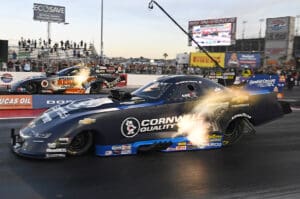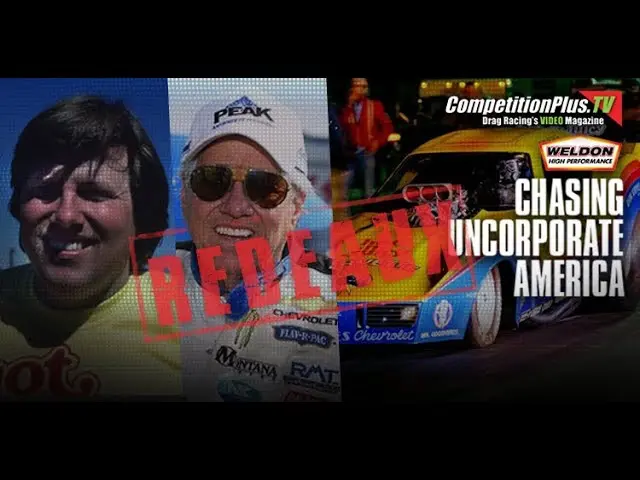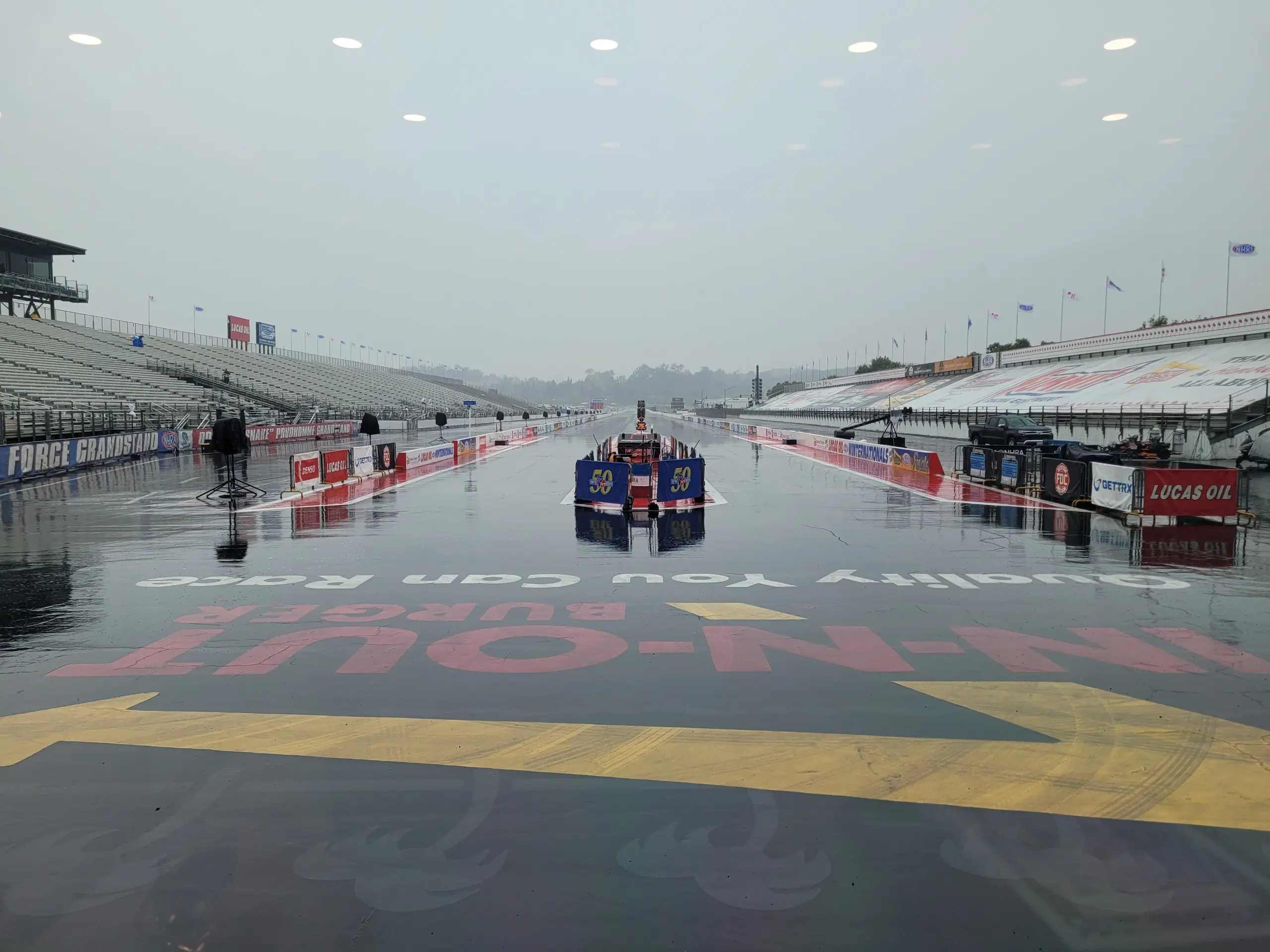
The letter, sent to the team by NHRA’s Glen Gray on Saturday evening, informed them of their need to correct their intake manifold, the same one they were running last weekend in Houston. The timing couldn’t have been worse.
“The NHRA Pro Stock rules committee has met and has voted not to accept your request to continue to use the Titan Engines Pro Stock intake manifold,” the letter read. “Please let this letter serve as [the] NHRA official rejection of your request. The NHRA Pro Stock rules committee did, however, vote to allow you to continue to use the intake manifold in question until June 1, 2022. At any NHRA event occurring after June 1, 2022, you must use an intake manifold that meets NHRA rules as defined in the NHRA Pro Stock electronic fuel injection requirements found on nhraracer.com.”
And, as an NHRA official confirmed, the letter was merely to inform the team they had until June 1, 2022, to bring the intake manifold into compliance with the established rules for the item.
However, within hours of driver Caruso claiming her first pole position at the NHRA Springnationals outside of Houston, news of the letter made its way through the pits and social media, where perception became a reality in a hurry.
Mike Smith of Titan Racing Engines was all too willing to explain the situation.
“This is the same intake we ran in ’18 on Tanner’s [Gray] car and Drew’s [Skillman] car. And then Elite bought the engines from Shane [Gray], and they ran them in ’19 and ’20,” Smith explained.
Smith confirmed the NHRA reclarified the rule in 2020.
“Originally, the way the rule was written, it said the injector had to be in the runner,” Smith explained. “People were getting creative and basically on the outside of the manifold, making it look like the runner went up higher so they could get the injector higher. So in ’18, [NHRA] made a rule where they put a drawing out that said, ‘Okay, this is the runner.”
“So basically below the radius, so that if you look on NHRARacer.com, there’s a drawing of an intake manifold, and it has green areas and red areas where, ‘Okay, this is good. The injector can be here in the green area, not in the red area.”
Smith said the items in question on the intake were there in 2018 and were nothing new.
“Our stuff that we had in ’18, the injector was there before the rule ever came out,” Smith said. “It was below the radius. But we had actually, over time, because we were trying different angles on the injector and stuff, we had cut the opening that the injector went through. Because obviously it’s got to spray through the. You got to have a hole for it to go through into the manifold.

“What we did, we put a transfer punch in there to show where the injector was coming through the hole at. And so our injector is below the radius, but over time doing different R & D stuff, the hole has gotten up into the radius. So in ’18, they went back and reviewed it, and they sent us an email at Gray Motorsports in ’18. It said, ‘Yes, you’re legal. It’s fine.”
In the 2020 reclarification, Smith said the specs changed.
“Now, the injector and the opening cannot be in the radius. So because our stuff still had the opening in the radius, they just basically want us to fill the opening hole and redrill it, so everything is below the radius in the runner,” Smith said.
Smith believes the reclarification was needed because he believes some teams were getting creative.
“NHRA reclarified the rule and that the opening for the injector and the injector both have to be below the radius,” Smith said. “I think it just simplifies the process for [NHRA]. They can look in there and go, ‘Yes, everything’s below the radius, and we’re good.”
“Where if they left it where the opening could be in the radius, then you’ve got to take the manifold apart, put a transfer punch in there, show that the injector’s below the radius. It just makes everything more complicated.”
Smith said NHRA didn’t mince words in their conversation with him.
“They told us flat out, basically if we thought this was a performance advantage, you wouldn’t be running it right now; we’d have told you to take it off,” Smith said. “We realize your injector is where it’s supposed to be; it’s below the radius. You just need to fill that in to bring it into compliance with the wording of the rule for today.”
Richard Freeman, whose Elite Performance formerly owned the engines and manifold in question, said the blowup over the intake was unnecessary
“The Carusos did nothing wrong,” Freeman told CompetitionPlus.com. “Instead of talking about, in my opinion, [Camrie] having a standout weekend and being a first-time all-girl final. It says a lot about our class… Instead of negativity about our class. I responded to a social media quote yesterday, which I don’t usually do, but what people need to be talking about is how the sorry old people at Elite Motorsports have made not only renting but owning your own equipment and being able to go out and compete for part of the game. That’s what we’ve done.

That’s of little solace to fellow Pro Stock racer Chris McGaha, who was in total opposition to how the NHRA handled the whole scenario. He believes there shouldn’t have been a grace period, regardless if there was no perceived performance advantage.
“I’m beyond unhappy about it,” McGaha said. “I spoke with NHRA tech about it Sunday afternoon. Told them what BS it was. I reminded them how I got a run tossed last year over a tech violation at Pomona. They quickly told me how it was different as mine was a safety issue over a helmet eject. I reminded them of my biggest complaint at that time was how they never toss anybody over performance issues. They just allow it, which they claimed they don’t but just provided proof that I’m right.
“Rules are rules… safety or performance. I was then told this team had a letter of approval for their intake, which seems very strange to me cause the rules are cut and dry, and I never have had a letter of approval for the 100-plus intakes I have built and ran on my car since 2016.
“So my question to tech was then if you go get a Stock or Super Stock guy and bring them over to teardown and they’re running illegal parts, what do you do? The reply was, ‘we throw them out.”
“I said, ‘okay, what’s the difference here?”
“They have a letter of approval. So it appears all you have to do is get a letter of approval, and you can bypass the NHRA rulebook, which really only consists of one rule anyway. At NHRA s discretion.”
Smith said he expects the shop to have the intake within spec by the end of the week and will be testing within the next two weeks.
“When we go to Epping, it will be the exact same intake manifold we ran in Houston,” Smith added.






































